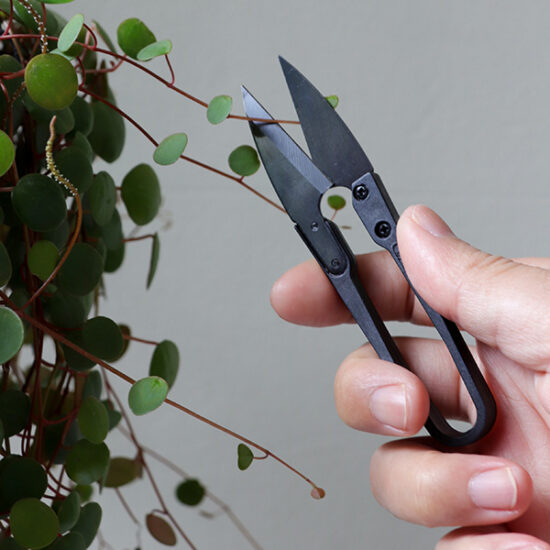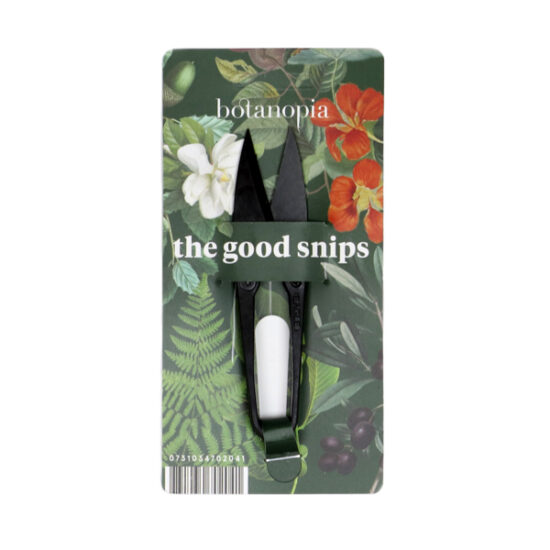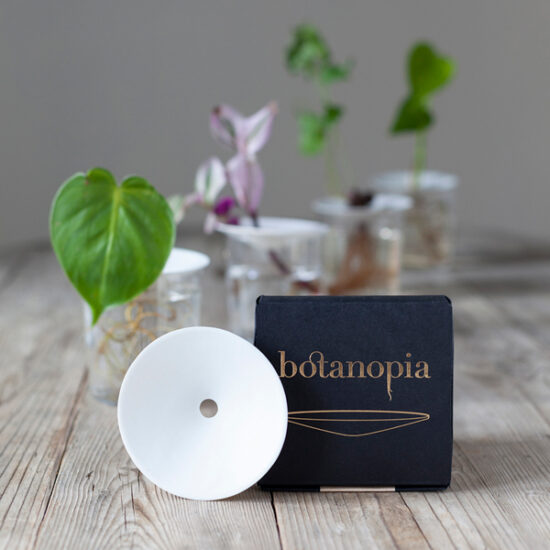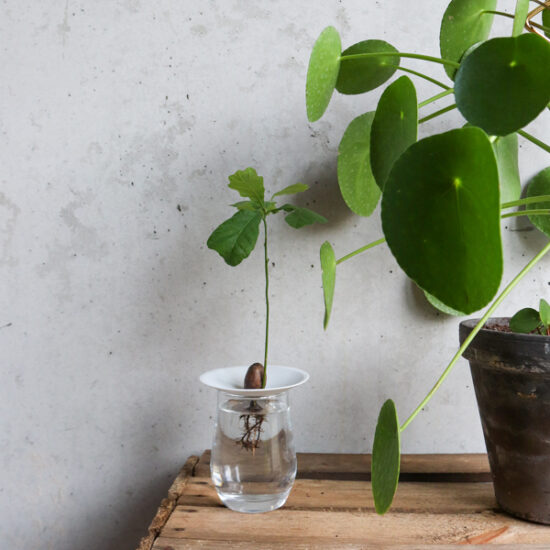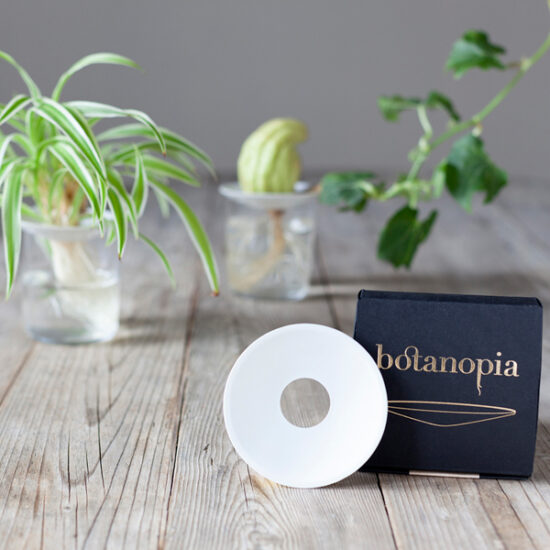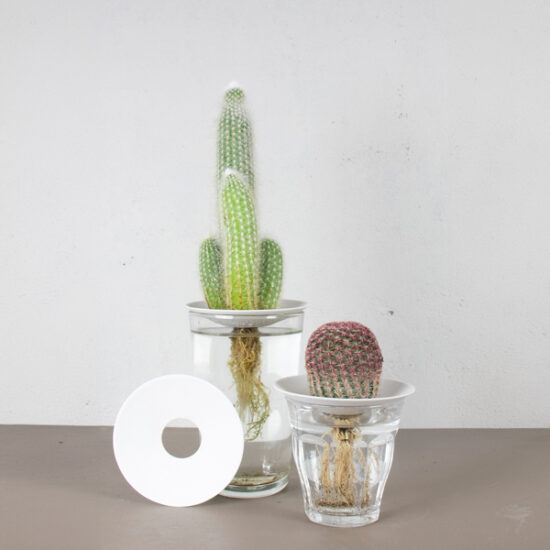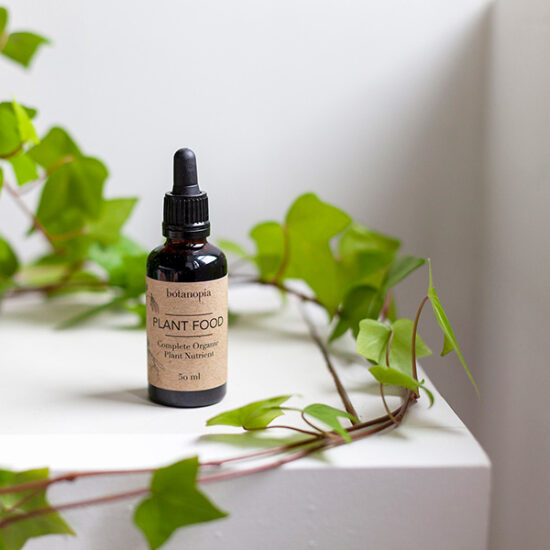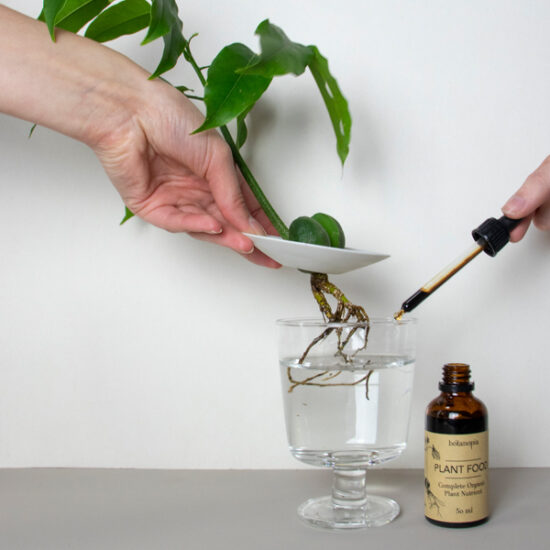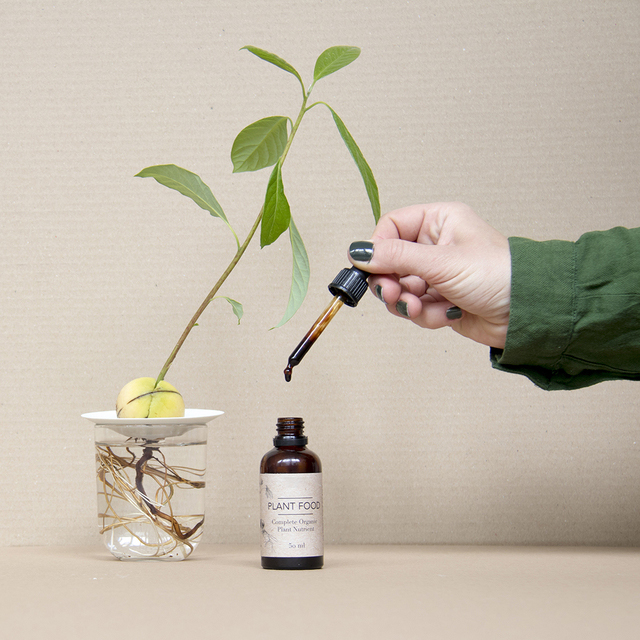The ultimate guide to growing your own avocado pit every time.
At Botanopia, we have more than 5,000 avocado pits under our belt. We’ve tested everything from germination to pruning the plant. Here are all our tips so that you too can finally grow your own avocado plant.
Why grow an avocado pit?
There are plenty of good reasons to do it. Perhaps you remember the failed attempts as a child, or even recent ones? Are you looking for new, original and free plants? Are you looking for a new activity to keep you busy at home? Do you think it’s a shame to throw away the pit every time you eat an avocado? Do you like to observe nature? Then let’s go and discover our fail-proof, very easy, method to germinate your avocado pit. It’s also the fastest.
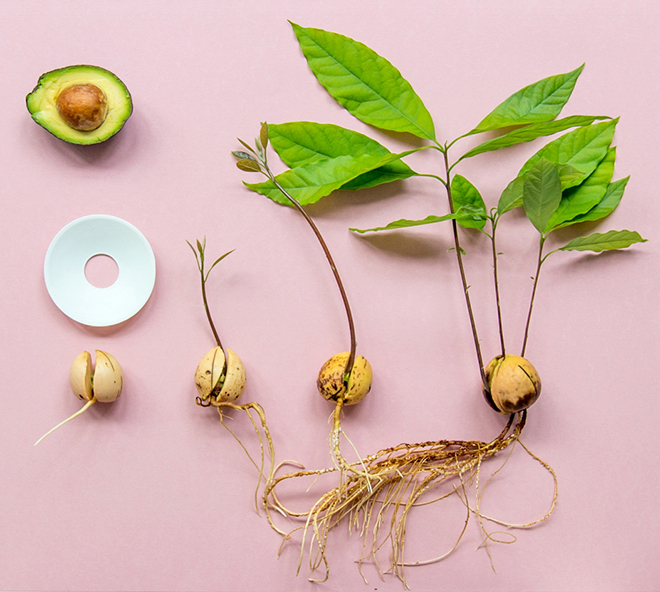
How to germinate your avocado pit
Throughout this article, you will learn how to germinate your avocado pit.
A pit, like all seeds, is a little reserve of energy designed to create a new plant. To awaken this enormous potential, you need to create the ideal conditions for your seed to grow. The avocado likes a tropical environment: it needs warm temperatures and constantly high humidity to germinate. Here’s how to create an ideal little incubator for your seedling.
What you will need
For the first step, you’ll probably find the necessary materials in your kitchen. You will need:
- A glass of water
- A good knife
- A paper towel or paper napkin
- A resealable plastic bag or an airtight container
- Nice to have: a germination plate
That’s it, let’s start growing!
Complete step by step guide
Here’s our complete guide to show you how to grow your own:
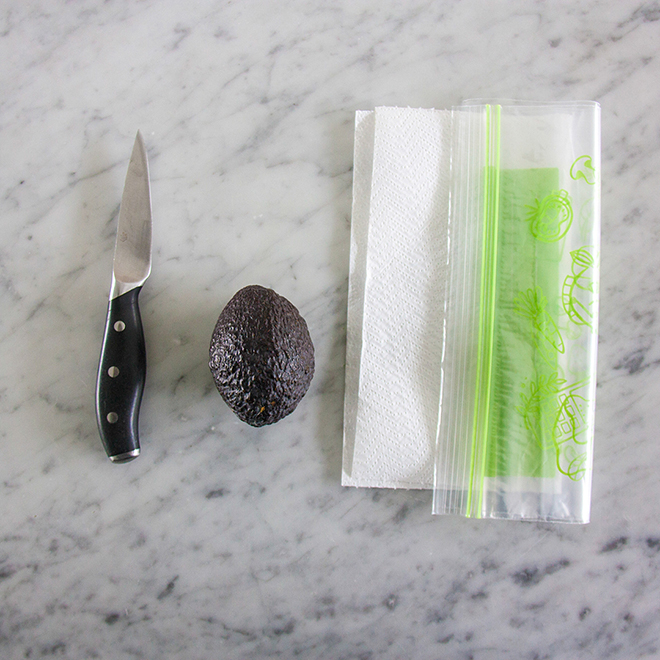
Take a good knife, an avocado, a paper towel and a plastic bag.
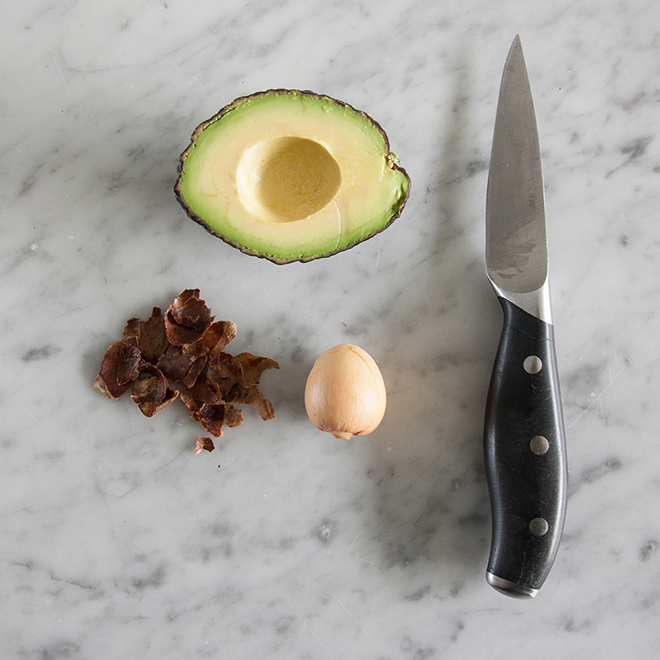
Open your avocado, eat the flesh and wash the pit well. First, soak the pit for 24 to 48 hours in clean water. With your knife, peel off the thin brown skin of the pit. This step speeds up the germination process and the result is more attractive.
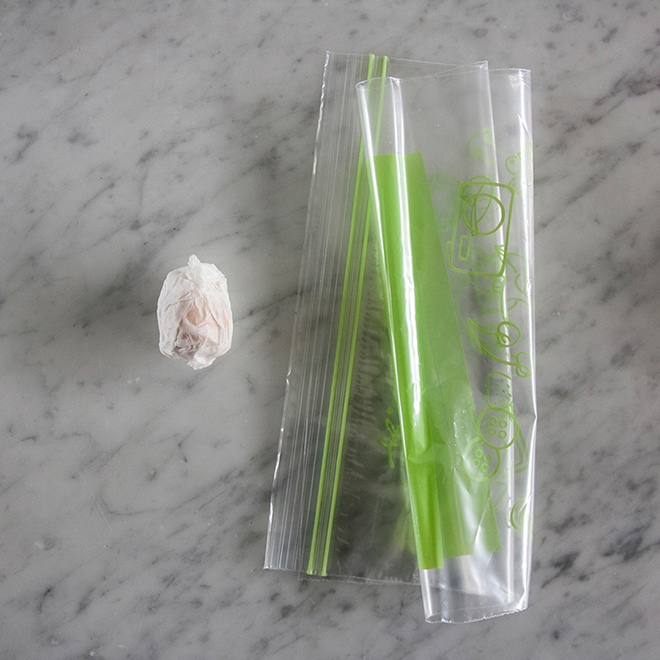
Wrap the pit in the damp paper towel. Put the whole thing in a plastic bag, close it tightly, and place the bag in a warm place in the dark. The ideal temperature for rapid germination is 25°C. Look for a place in your house that is always warm, for example next to your boiler or water heater. Then wait!
Check in the bag from time to time to see if the magic has started and make sure the towel doesn’t dry out. If it does, rewet it slightly.
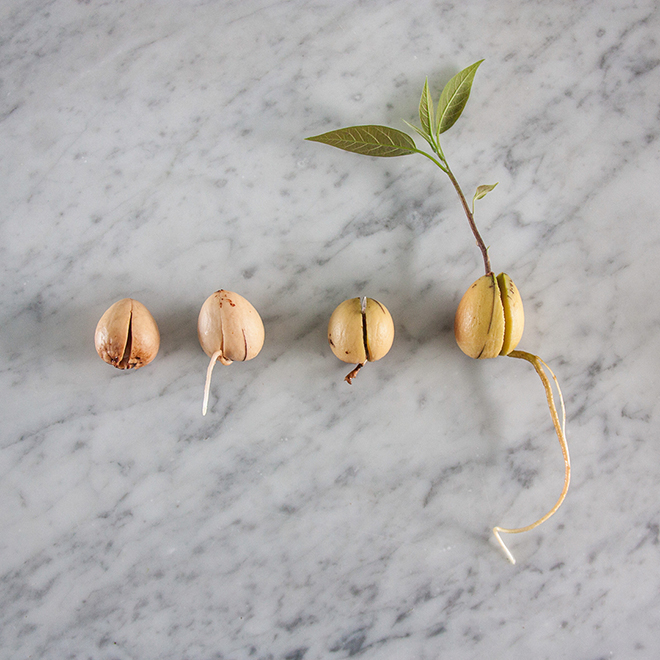
The pit will first split in two, then a root will emerge, and finally a stem/first leaves. When the root is a few centimetres long, you can take the pit out of the bag and continue growing in water or potting soil.
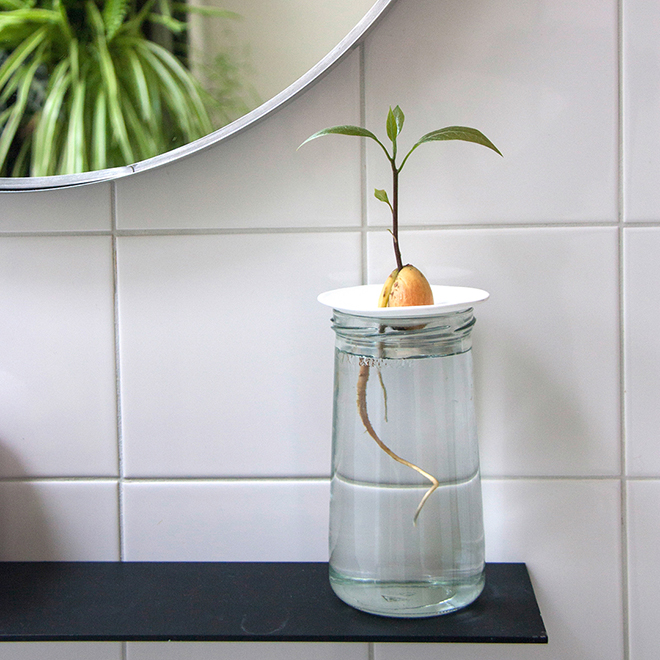
We like to grow our avocados in water (hydroponics), perched on our specially designed porcelain germination plates. They prevent the water from evaporating too quickly, so maintenance is very easy. A great view on the roots is guaranteed (and it’s pretty!). A little floating forest on your kitchen table.
The best things to do the job:
-
Sale! Original price was: 4,74CHF.3,95CHFCurrent price is: 3,95CHF.
How to care for your avocado plant
Here are our best tips to take care of your avocado plant.
In general, an avocado needs a lot of light, and does not tolerate cold, nor does it dry out its roots. If it receives too much direct sunlight, the leaves will turn red (it’s quite pretty by the way, not like me on the beach after a sunburn…)
Care tips for avocados growing in water
If you like to watch your avocado grow in water, you can keep it indefinitely in hydroculture mode. There’s no need to plant it in soil, unless you want to.
Some tips for a healthy avocado plant:
- Change the water very regularly, at least once a week. By changing the water completely (not just top it up), it will also be oxygenated, which is necessary for your plant.
- Add a suitable liquid fertiliser, as there are no nutrients in tap water to help your plant grow. Be careful: chemical fertilisers can burn the roots, so use an organic plant-based fertiliser.
By following these two basic tips, you will be able to keep your avocado growing in water for years.
The 5 biggest mistakes to avoid
Here are the five mistakes we see most often with avocados:
- Keeping the pit too cold:
if the temperature’s too cold, your avocado will have difficulty growing. It may still sprout, but it will take much longer. The ideal temperature is about 25°C. Keep your little plastic baggie next to your water heater or furnace so it stays consistently warm.
- You didn’t soak the pit:
If you don’t soak your pit, it won’t yet have reached the necessary moisture level to trigger germination. Soak it in water for 1 or 2 days.
- You didn’t peel the skin:
This slows down germination. In the end, the thin brown skin will flake off the pit anyway, which doesn’t look great. It’s more efficient to remove it from the start.
- You let the pit dry out by not closing the bag properly
If you don’t close the bag properly, the pit will dry out and the ideal humidity that triggers germination will not be reached. If your paper towel is not wet enough, the same problem can occur. Be careful if you leave the bag near a strong heat source (radiator), the risk of drying out is higher.
- You worked with dirty hands
Wash your hands before handling the pit, otherwise you risk introducing bacteria into the bag. Bacteria will also love the “incubator” conditions to proliferate. If your pit develops a strong acidic smell, like vinegar, it’s too late… You’d better try your luck with a new pit.
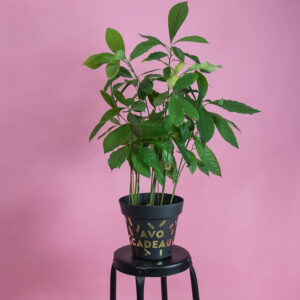
Replanting your avocado in soil
If you prefer to plant your avocado in soil or in your garden, it’s very easy. We have some tips for you.
When to plant your avocado stone in the ground?
It’s a personal choice, as soon as your first root is a few centimetres long, you can replant. But you can also do it much later. Styling tip: you can also plant several pits together in the same pot for a bushier result.
You need a pot and some potting soil, nothing more. We like to use terracotta pots because they are available everywhere and are very affordable. Choose a pot with a drainage hole, which allows excess water to escape and prevents the roots from rotting. If you don’t use a pot with a hole, we recommend that you use ceramic beads (LECA) at the bottom of the pot to facilitate drainage.
First, you’ll have to take the avocado out of the germination plate. Don’t be afraid to damage the roots, they grow back very quickly. The plant will develop a new type of roots in the soil anyway. You can reuse the germination plate to grow other plants or fruits, such as a mango or a cactus.
Start by putting some soil at the bottom of the pot. Then add the pits and fill in with soil around the roots.
Important: water roots and soil roots are not quite the same. Your plant will have to adapt and produce new soil roots. During this transition, keep the soil moist to limit stress to the plant. After a few weeks, the new roots will take over and you can decrease the waterings.
And that’s it, well done!
Ideal growing conditions
How deep should I bury the pits in the soil?
It doesn’t really matter how deep you plant the pit in the soil, it can be visible or covered with soil. In any case, once the core has been emptied of energy, it will be composted and absorbed into the soil and will not be seen again.
My plant is a bit droopy after repotting, what should I do?
Don’t worry, your plant is a bit stressed because it’s transitioning from water roots to soil roots. Keep the soil quite moist for a bit and your plant should recover quickly.
How do I care for my plant in the first few weeks?
Make sure that the plant remains moist to facilitate the absorption of water by the original roots. The advantage of a pot with a hole in it is that the excess water will escape. After the new soil roots have grown, the soil should be kept slightly moist. If you let the soil dry out, the leaves of your avocado will also dry out permanently around the edges.
What climate is best suited to growing avocados?
Avocados are tropical plants that grow mainly in warm countries. In the wild they grow into large trees up to 20m tall, but indoors they do not grow very large. If the temperature outside drops below 10 degrees, you should bring your avocado inside, otherwise it will not survive the winter. Avocados like sunlight, but if you see that the leaves are turning red, it’s because there is too much sun.
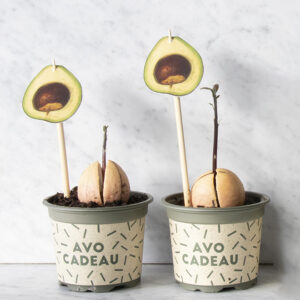
How to prune your avocado
When the avocado grows, it produces a stem for each pit. Sometimes the stem will be very tall with leaves at the end but not along the stem. This is often a sign of lack of light, the stem stretches towards the sun to catch the available sun rays. If you don’t think it’s a nice look, you can prune the stem, to encourage side shoots and a bushier look. It’s up to you to decide when you want to prune it.
To prune the stem, cut at the height at which you want the new branches to start forming. The pit will then need plenty of sun, fresh water and good care. New branches will soon start to emerge from the stump of the stem. You can prune your avocado whether it’s in soil or in water.
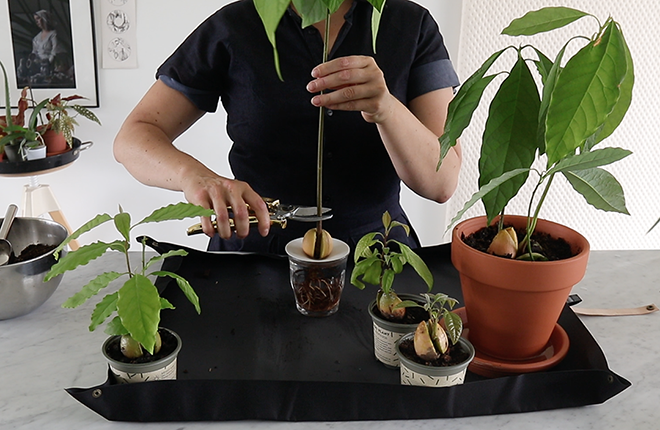
Watering
There is no perfect, universal method for watering your avocado plant. It depends on many factors such as temperature, climate, type of pot, and amount of light. In general, you should keep the soil slightly moist.
If you forget easily, try to choose one day a week for watering, it will become a little ritual (at Botanopia, it’s Friday!)
If you find it difficult to manage the watering of your plants, we recommend using a Soil Checker. Just stick it in the ground, turn it and pull it back out. Soil gets trapped in the notches, so you can feel if it’s moist or dry, all the way to the bottom of the pot. If the first 5-7cm (2-3 “) are dry, it’s time to water again.
Why the toothpick method doesn’t work
Does this remind you of a vague memory from your childhood?
3 toothpicks stuck in the pit to hold it above water?
You may have tried this toothpick technique before to grow your avocado. If it didn’t work, here’s why.
This technique seems simple and quick, but it rarely works and takes much longer.
The reason is simple: the pit is not placed in ideal germination conditions.
As we showed you before, in order for the seed to start germinating, you have to wrap it in a wet paper towel and put it in a ziploc bag. If it’s just hanging over the water with toothpicks, the water will evaporate, and the humidity will be too low. The temperature in our homes is also often too cold, which slows down the process.
Do you prefer an explanation in video form?
If you prefer to see all our best tips on video, to know exactly how to do it, we have a very comprehensive video for you:
So when can I harvest my avocados?
I am sure that you want to harvest your avocados as soon as possible. Let me explain you how it works.
For your avocado tree to bear fruit, several conditions must be met. Your avocado tree must be planted in the ground or in a large pot.
The perfect climate for your avocado tree to produce fruit is a tropical climate with mild winters.
In Northern Europe, like at the Botanopia office in Amsterdam, this is simply not the right climate, and you will not be able to harvest fruit from your avocado tree.
For the lucky ones who live in sunny countries like Spain, your avocado tree will grow best along the coast. At higher altitudes, the ripening of the fruit is delayed.
You can harvest the fruit 8 to 10 years after planting your avocado tree.
For the rest of us, there are plenty of good reasons to grow your own pit:
You’ll learn a lot, you’ll have a good time gardening and watching the growth, you’ll get a nice green plant for free and you’ll be the envy of all your friends who still have bad memories of the toothpick method.
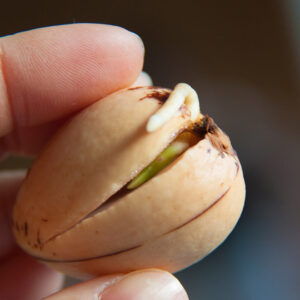
Which avocado variety should I choose?
There are many varieties of avocados. The dominant varieties are the Hass and the Fuerte, which can be found everywhere in supermarkets. The Fuerte avocado is grown in Israel, while the Hass avocado comes from Spain, Mexico or South Africa. You can plant your avocado tree with any variety of avocado pit. We just advise you to use an organic avocado pit because we find them to grow faster and the resulting plant is more vigorous.
Frequently asked questions about avocados
My pit is turning green, is this normal?
No need to worry! Your stone turns green when it comes into contact with light, this is normal. You peel the pit and remove the brown skin to speed up the germination process. You don’t have to remove the skin, but if you don’t remove it, it may delay the sprouting process by a week or two.
While removing the skin I cut the into the pit with my knife, is that a problem?
No problem, it’s not serious. Even if part of the pit has been removed, it doesn’t change anything for the seed. The only thing to remember is that every time you make a cut in the pit, the cut will oxidize and turn black. At Botanopia we like to play with this by engraving the pit with a knife or a laser. We’ve made a little video to show you how.
Can I use the germination plate to grow other plants?
Yes, you can use your plate to grow many plants and seeds like acorns, mangoes, lemons, beans, and even nuts. Check out our videos on how to do this.
And now that you know everything, get growing and tag us in your result photos @Botanopia_
Botanopia
Avocado pit tatoo tutorial

